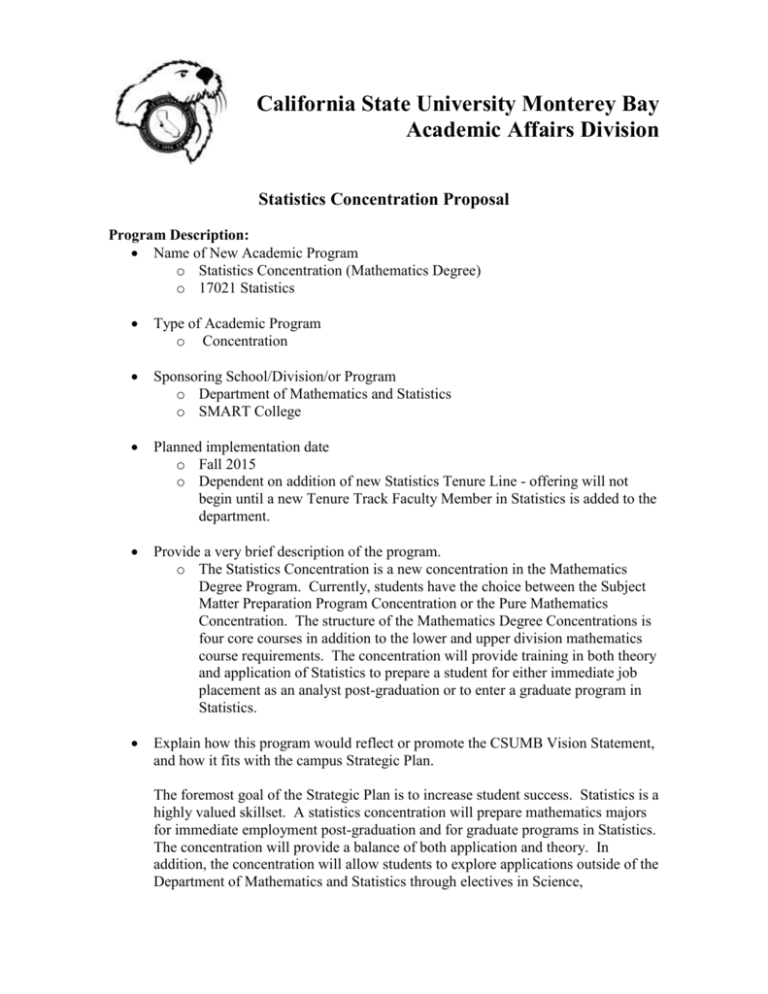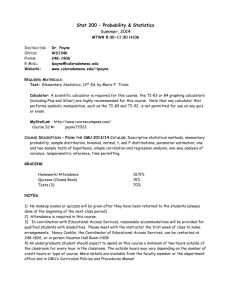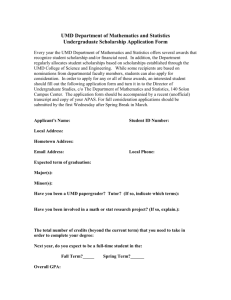Proposal for Newly Projected Programs on an Academic Plan
advertisement

California State University Monterey Bay Academic Affairs Division Statistics Concentration Proposal Program Description: Name of New Academic Program o Statistics Concentration (Mathematics Degree) o 17021 Statistics Type of Academic Program o Concentration Sponsoring School/Division/or Program o Department of Mathematics and Statistics o SMART College Planned implementation date o Fall 2015 o Dependent on addition of new Statistics Tenure Line - offering will not begin until a new Tenure Track Faculty Member in Statistics is added to the department. Provide a very brief description of the program. o The Statistics Concentration is a new concentration in the Mathematics Degree Program. Currently, students have the choice between the Subject Matter Preparation Program Concentration or the Pure Mathematics Concentration. The structure of the Mathematics Degree Concentrations is four core courses in addition to the lower and upper division mathematics course requirements. The concentration will provide training in both theory and application of Statistics to prepare a student for either immediate job placement as an analyst post-graduation or to enter a graduate program in Statistics. Explain how this program would reflect or promote the CSUMB Vision Statement, and how it fits with the campus Strategic Plan. The foremost goal of the Strategic Plan is to increase student success. Statistics is a highly valued skillset. A statistics concentration will prepare mathematics majors for immediate employment post-graduation and for graduate programs in Statistics. The concentration will provide a balance of both application and theory. In addition, the concentration will allow students to explore applications outside of the Department of Mathematics and Statistics through electives in Science, Psychology, and Health and Human Services. The students will develop technical skills in statistical computing software within the courses of the concentration. In addition, students will acquire practical experience in consulting through service learning. Collaboration will be emphasized within the course curriculum through group projects and lab assessments. Describe the primary student population that this program would intend to serve. o Though the immediate service of the concentration would be to current Mathematics Majors – the concentration will allow interdisciplinary programs to develop, as the courses in the Statistics Concentration could serve multiple degrees in Science, Business and ITCD. Rationale and Demand for Program: Provide a brief rationale for proposing the program. o The demand for trained Data Scientists is increasing daily. The Harvard Business Review, Google and other major influences on business and industry have publicized the need to Statistics training in today’s economy. The Statistics Concentration would create opportunities for our students to receive training in a highly demanded profession Provide evidence that there is student demand for this type of program. o The Statistics Minor (which has been offered since fall 2011) has steadily grown over the last two years. Many mathematics majors have added the statistics minor to their individual learning plan, but many are blocked from pursuing the minor due to the demands of their major and inability to add the courses to their program without extending the time to graduation by one or even two semesters. The concentration would allow Mathematics majors to pursue study in Statistics without extending their college education. Provide evidence that the community, the region, or the state have a need for this type of program. o We have offered a new service learning course called MATH 362S: Mathematics Consultants. The demand for our students to provide statistical analysis to non-profit organizations and school districts is outstanding. In addition, local employers such as the Defense Manpower Data Center have hired and hope to hire more of our students that have a sufficient statistical background. In addition, companies such as Google, Apple, Facebook, Cisco, have a high demand for employees with statistics training. The State of California projects a 20% increase in available jobs that require training in Statistics by the year 2020. In addition, there are over 70,000 employers in the State of California that current employ Statisticians. (All employment statistics from CA EDD.) 2 Resources and Expected FTES: At least 11 of the 23 CSU campuses have statistics programs (concentrations or minors). Given the projected size of the campus (up to 10,000 students), if we compare to CSU East Bay (~10,000 students) their current FTE is 266.3 (2.2% Dist). Sonoma State launched their Statistics Program (first graduates 2008) and have graduated 20+ Statistics majors since (note this is a major, not a concentration). Since our proposal is a concentration, the courses for the concentration may be taken by both Statistics concentration students and General Mathematics majors. Though we are currently a smaller campus than Sonoma State, our mathematics departments are comparable in size. To provide some understanding of the relative costs of operating this program, briefly describe the new resources that would be needed in the following categories: - New faculty positions o At least one new tenure-track position in Statistics - New courses and/or additional sections for existing courses o Courses proposed on the 2013 consent calendar STAT 210: Statistical Computing Tools STAT 420: Statistical Theory I STAT 421: Statistical Theory II If additional resources will be required, indicate the extent of the university’s commitment to allocate them and provide evidence that decision-making curriculum committees were aware of the sources of resource support when they endorsed the proposal. o None Other CSU System Information: If the new degree program is not commonly offered as a bachelor’s or master’s degree, provide a compelling academic rationale for explaining how the proposed subject area constitutes a coherent, integrated degree major that has potential value to students. o Many other CSUs have either degree programs or options within degree programs for Statistics (see below) CAMPUS DEGREE MAJOR (CONCENTRATION) Bakersfield BS Mathematics (Statistics) Chico BS Mathematics (Statistics) East Bay BS Statistics (Statistics - General) 3 Fullerton BA Mathematics (Probability and Statistics) Long Beach BS Mathematics (Statistics) Northridge BS Mathematics (Statistics) Pomona BS Mathematics (Applied Mathematics/Statistics) San Diego BS Statistics (Statistical Computing) San Diego BS Statistics (Actuarial Science) San Francisco BS Statistics (Statistics - General) San Jose BS Applied Mathematics(Statistics) San Luis Obispo BS Statistics (Statistics - General) Sonoma BA Applied Statistics (Applied Statistics - General) Sonoma BS Statistics (Statistics - General) Concentration Outcomes and Rationale The following outcomes are adapted from the American Statistical Associations guidelines for undergraduate statistics programs: http://www.amstat.org/education/curriculumguidelines.cfm Learning Outcomes 1 and 2 satisfy the ASA recommendation for a sequence of two courses (for example, an introductory statistics course and an applied regression course) structured to cover the core topics of data production, inference, and applied modeling should be included. The Learning Outcomes also satisfy the ASA recommendation for 3-5 electives courses And include any that would qualify as electives for the major in statistics, probability, and, in the case of minors, courses in other disciplines (e.g., econometrics) that have a substantial statistical component distinct from the introductory material in the core sequence. Since the concentration is nested within the Mathematics majors, two of the required courses are theoretical (STAT 420, STAT 421). 4 Learning Outcome #1 Students use a variety of general statistical methods to demonstrate statistical thinking and to tests hypotheses using t-tests, ANOVA, randomization methods, bootstrapping and basic data analysis. Students demonstrate knowledge of sampling and experimental design. MATH 320: Applied Probability and Statistics (4 units) Concepts and applications of sample space, probability, random variable, expectation, moment, elementary combinatorial analysis, moment generating function, distribution, density function, estimation theory, hypothesis testing, regression, correlation, and an introduction to non-parametric statistics and statistical computing. STAT 320: Mathematical Statistics (4 units) Reviews basic introductory statistics with an overview of basic probability theory. Extends the scope of statistics by teaching theory through application with a focus on the use of programming and nonparametric resampling techniques in hypothesis (permutation) tests, sampling distributions, chi-square tests for independence and goodness of fit, bootstrap, estimation theory, one-way ANOVA and simple linear regression. Learning Outcome #2 Students use statistical modeling to determine significant predictors or explanatory variables of a defined response variable and to make and assess predictions of the response. STAT 410: Applied Statistics Methods: Linear Models (4 units) Includes simple linear regression, multiple linear regression, variable selection techniques, stepwise regression, analysis of variance (one way and two-way, block and other designs), multiple comparisons, random and fixed effects models, residual analysis, and computing packages. Learning Outcome #3 Students explain the underlying mathematical theory of statistical inference using methods from probability theory, real analysis, linear algebra and mathematical statistics. STAT 420: Statistical Theory I (4 credits) Theory focused probability tools for statistics: description of discrete and absolutely continuous distributions, expected values, moments, moment generating functions, transformation of random variables, marginal and conditional distributions, independence, order statistics, multivariate distributions, concept of random sample, and derivation of many sampling distributions. 5 STAT 421: Statistical Theory II (4 credits) Theory focused framework for statistical inference: point estimators: biased and unbiased, minimum variance unbiased, least mean square error, maximum likelihood and least squares, asymptotic properties. Interval estimators and tests of hypotheses: confidence intervals, power functions, Neyman-Pearson lemma, likelihood ratio tests, unbiasedness, efficiency and sufficiency. Learning Outcome #4 Students will learn some form of professional statistical software so that the student may analyze hypothesis tests and statistical models. Programs may include R, SAS, SPSS, JMP, or other appropriate software. STAT 210: Statistical Computing Tools (1 unit) Self-paced lecture series to learn and apply statistical computing software. Learning Outcome #5 Students serve as consultants to community organization, school districts and businesses. MATH 362S: Mathematics Consultants (5 units) Service learning placements in local non-profit organizations, school districts and community organizations help students deepen their understanding of mathematical and statistical principles, techniques, and methodologies for effective consulting. Students will also study how the need for mathematical and statistical analysis can influence issues of social justice and equity within the local and global community. Statistics Concentration at CSUMB Course Requirements Lower Division Core ~ 24 credits MATH 150: Calculus I (4 units) MATH 151: Calculus II (4 units) MATH 170: Discrete Mathematics (4 units) MATH 250: Multivariate Calculus (4 units) MATH 265: Diff Equs & Linear Algebra (4 units) CST 231/L: Problm-Solving/Programng (4 units) Upper Division Core ~ 24 credits MATH 300: Major Proseminar (4 units) MATH 320: Applied Probability and Statistics (4 units) MATH 322: Foundations of Modern Math (4 units) MATH 330: Advanced Linear Algebra (4 units) MATH 400: Capstone Seminar (4 units) MATH 420: Mathematical Analysis I (4 units) 6 Statistics Concentration ~ 25 credits STAT 210: Statistical Computing Tools (1 unit; Recommended) MATH Elective (4 units) - Recommendations MATH 410: Modern Algebra I (4 units) MATH 421: Mathematical Analysis II MATH 374: Mathematical Modeling (4 units) MATH 375: Numerical Analysis for Mathematics and Statistics (4 units) Other Upper Division Math Course MATH 362S: Mathematics Consultants (5 units) STAT 410: Advanced Statistical Methods: Linear Models (4 units; pre-req MATH 320) STAT 420: Statistical Inference I (4 units; pre-req MATH 322, MATH 320) STAT 421: Statistical Inference II (4 units; pre-req STAT 410) STAT Elective (4 units) STAT 320: Mathematical Statistics (pre-req MATH 320) STAT 395: Special Topics in Statistics (pre-req MATH 320) Upper Division Elective from outside the department with Approval Advisors Lead: Dr. Judith Canner Other: Dr. Hongde Hu Dr. Lipika Deka Dr. Rachel Esselstein Dr. Michael Scott Dr. Heath Proskin Dr. Don Peirce 7 Proposed Course Pathway Calendar for Incoming Freshmen with Pre-Calculus Fall Semester 1 MATH 150: Calculus I/ B4 GE FYS (C2) Language (C3) GE (A1, A3) Fall Semester 3 MATH 250: Multivariate Calculus Math 170: Discrete Math MATH 265: Differential Equations and Linear Algebra GE (E ) Fall Semester 5 MATH 410: Modern Algebra I MATH 330: Advanced Linear Algebra STAT 410: Advanced Statistical Methods: Linear Models GE (C1) Fall Semester 7 MATH 300: Major Proseminar STAT 420: Statistical Inference I MATH 420: Mathematical Analysis I Credits 4 4 4 4 16 Credits 4 4 4 4 16 Credits 4 4 4 4 16 Credits 4 4 4 12 Spring Semester 2 MATH 151: Calculus II CST 231/L: Problem-Solving/Programming Language (C3) GE (D1) Spring Semester 4 MATH 320: Applied Probability and Statistics MATH 322: Foundations of Modern Math SL 200S: Service Learning (D3, D2) STAT 210: Statistical Computing Tools Spring Semester 6 MATH 362S: Mathematics Consultants Statistics Elective (STAT 320) GE (B2, B3) GE (B1, B3) Spring Semester 8 MATH 400: Capstone Seminar STAT 421: Statistical Inference II GE (A2) Elective Credits 4 4 4 4 16 Credits 4 4 5 1 14 Credits 5 4 4 4 17 Credits 4 4 4 1 13







